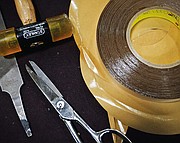Kootenai pollution numbers decrease
Alecia Warren | Hagadone News Network | UPDATED 14 years, 11 months AGO
COEUR d'ALENE - It's a strange combination of the tough economy and evolving manufacturing.
But Kootenai County is that much cleaner.
The amount of chemical pollution produced by local companies dropped between 2008 and 2009, according to an annual Environmental Protection Agency report.
"That can mean a couple things," said Brook Madrone, EPA spokesperson. "It can mean some facilities are closing, or they're having decreased production. Or it can also mean they're better about recycling waste."
For companies in Kootenai County, it's all of the above.
Eleven Kootenai County businesses, including asphalt companies, sawmills and manufacturers, reported generating a total 242,774 pounds of chemical waste and emissions in 2009, according to the EPA Toxic Release Inventory National Data Analysis released last week.
That's 28,935 pounds less than in 2008, when 13 companies reported producing 271,709 pounds.
The slip is at least partly because of the recession, said Mark Boyle, Coeur d'Alene region air quality manager for the Department of Environmental Quality.
"A lot of facilities aren't operating as much as they have been in the past," Boyle said. "Sales are down."
Companies vouched for that.
The county's drop in chemical pollution was mainly because emissions plummeted at Dynamic Fabricators LLC, a fiberglass manufacturing plant previously located in Rathdrum.
It's because of floundering demand, said former owner Wade Wolcott, that the plant's emissions nearly halved from 81,224 pounds in 2008 to 46,616 pounds the next year.
"The volume through the plant was substantially less, because of the economy," Wolcott said, adding that chemicals like styrene are released in air emissions as part of the manufacturing process. "Every business (decline) is economy related."
Wolcott, a Spokane resident, said he sold the company in September 2009 to Amtech, LLC in Wapato, Wash., which closed the facility shortly thereafter.
Aleris Recycling Inc., which produces most of Kootenai County's chemical pollution, also scaled back production last year because of the economy, said spokesperson Kristen Bihary.
Yet its pollution increased.
"The explanation for that would be the material we're recycling," Bihary said. "Depending on the composition of that material, there may be more or less emissions associated with it."
The Post Falls company's chemical waste rose from 189,611 pounds in '08 to 195,248 pounds a year later.
The plant recycles aluminum scrap that generates aluminum dust, Bihary said. Three percent of that is released in air emissions, the rest deposited in a landfill.
"We're very concerned about sustainability and the environment, and comply with all regulations," she said.
Kimball Office in Post Falls, one of the lowest polluters in the county, only produced one pound of chemical pollution this year, according to the TRI Report.
The metal furniture manufacturer has been pursuing more eco-friendly methods, said John Brennan, Kimball safety, security and health manager.
For instance, a new coating spray that minimizes wastewater. The company also replaced its liquid paint with a powder version that creates nearly no hazardous waste.
"(About eight years ago), we were putting out 699 55-gallon drums of hazardous waste," Brennan remembered. "Now we send out one or two drums of waste per year."
Esterline Advanced Input Systems also reduced its waste by switching to a lead-free product to solder its electronics products, said spokesperson Dennis Staver.
"If you want to deliver any product in Europe, it has to be lead free," Staver said.
The company's mostly lead waste, which is recycled by a contractor, dropped from 248 to 230 pounds in 2009, according to the EPA report.
"We're happy about it," Staver said.
The EPA TRI Program compiles data on toxic chemical releases and waste management activities reported annually by certain industries and federal facilities across the U.S.
The pollutants released in Kootenai County aren't a huge cause for worry, said Kai Elgethun, a toxicologist with the Idaho Department of Health and Welfare.
Most of the highest released chemical, aluminum, is deposited safely in a landfill, Elgethun said. As for chemicals released in air emissions, companies are permitted under federal standards to release them at levels safe for humans.
"All of these things are permitted using the best available science the EPA has," Elgethun said. "It's a well done process."
ARTICLES BY ALECIA WARREN
Tribe's property taxes canceled
After a meeting with Coeur d'Alene Tribe officials today, Kootenai County commissioners voted unanimously to cancel all property taxes on reservation land from the past four years.
In hot water
Idaho DEQ says temps are too warm for trout
We like our fish cooked... But not before we catch them.
Past issues
Old charge blocks weapons permit
A Hayden resident believes his rights were violated when he was disqualified from obtaining a concealed weapons permit because of a felony charge from over 40 years ago.



